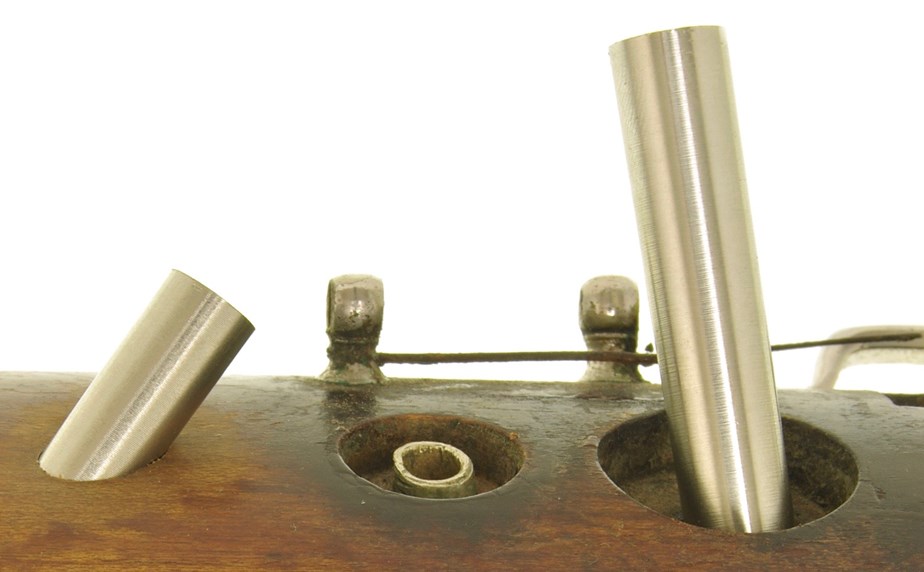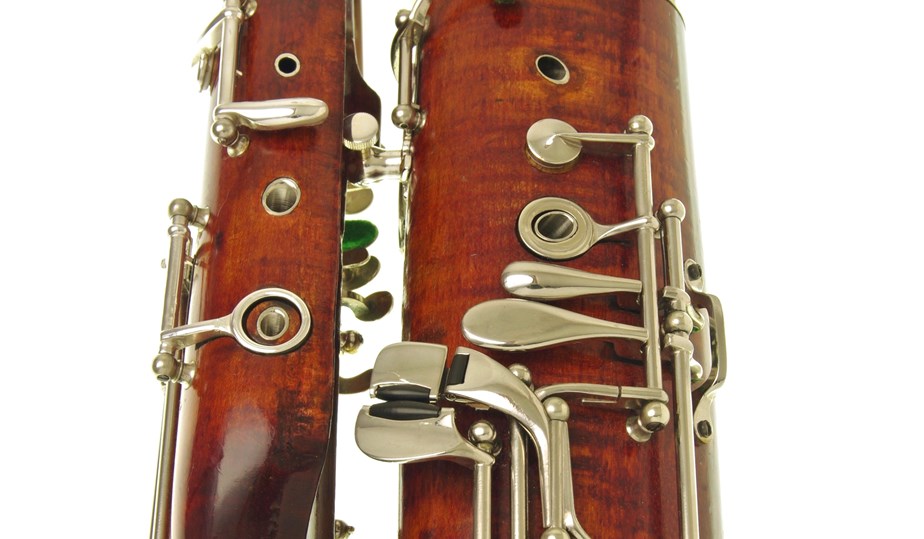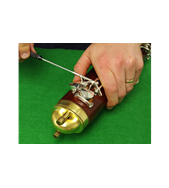Finger-hole liners: does my bassoon need them?
March 16th, 2018

Finger holes being installed on a pre-war Heckel 5000 in the Double Reed Ltd. workshop, prior to the tops being cut off and shaped
This is the second in a series of articles about pre-war bassoons – why they are so loved, what the potential problems are and how those problems can be solved.
What are finger hole liners and are they important?
Finger hole liners are protective waterproof sleeves inserted into the five finger holes on a bassoon, which help keep the bassoon in good condition.
Modern bassoons are usually made with finger hole liners installed as standard. However, most bassoons made before about 1960 were made without finger hole liners.
When a bassoon is played, moist air is blown into the instrument through the reed. Moisture in this air condenses on the cold rubber-lined bore of the bassoon and runs down into the U-bend. Owing to the angle of the finger holes, some of this water runs into the finger holes from the inside. Do you ever hear a bubbling noise when you are playing? This is caused by water entering the finger holes.
It is worth noting that having unlined (wooden) finger holes is usually no problem at all. If you treat your bassoon with reasonable care, the original wooden holes will sound great and they will not deteriorate with age. We see pre-war bassoons with the unlined finger holes in great condition and perfectly in tune.
However, if unlined finger holes are kept damp over a long period of time they can deteriorate. Any change to the shape of the hole affects the tuning and voicing of the bassoon. You will find some notes start going sharp, some start going flat, and some lose their power or tone quality. This is a result of the air flow being affected by the rough, out-of-shape wood.
As the deterioration is slow, it may be unnoticed or you may think that this is just how older bassoons are. But they will not have been made to sound like this, and the problem can be solved.
How do I know if my bassoon has unlined finger holes?
If you look at the finger holes on your bassoon and see the holes are just plain wood, then you know they are unlined. If they have a plastic or metal ring around the outside edge, then they are either partially or fully lined.
For a good many years after bassoons started having finger hole liners added at manufacture, some bassoons were only partially lined; that is, lined halfway down the hole, and then they stop. This can be even worse than no liners at all, as it allows the moisture to collect in the unlined part and then damage the wood.
Therefore, externally a bassoon may look as though it is protected, but can still suffer from rough and misshapen finger holes in the bottom section, and need new full liners inserted to bring the bassoon’s performance back to what it would have been originally.
How to assess the condition of your unlined finger holes
We are happy to assess your bassoon’s finger holes for you. However, you can take a quick look yourself by shining a light down the finger holes. The holes should be straight and smooth. If the wood is looking rough or has shrunken out of shape, then you are likely to need some remedial work carried out.
It is possible to re-ream the finger holes if they are not too bad, to smooth the wood out, but this is likely to be a temporary solution as the wood has probably softened and deteriorated and the problem will soon come back. The only long term solution is to have finger hole liners installed.
How may finger hole liners improve my bassoon?
Installing finger hole liners on a bassoon suffering from rough or out-of-shape holes can dramatically improve the sound. Typically, the benefits of installing finger hole liners can be as follows:
- Greater dynamic range - both significantly improved projection and an increased ability to play quietly
- Better intonation with a more even scale. Often the intonation improvements are dramatic, depending on how bad it was to begin with
- Freer high notes
Finger hole liners will stop the problem from recurring as the liners are designed to extend into the bore by about 1.5mm to allow water to run past the holes and down to the U-bend, rather than into the holes. The liners are also waterproof so they stop any ingress of water from coming into contact with the wood of the bassoon.
Top tip
Water in the bore and finger holes is normal, and will not harm either as long as you allow them to dry out after playing by swabbing the bassoon out, so that there is no water sitting in the bore or finger holes for extended periods of time.
To avoid your swab getting saturated, take a look at our selection of pull through cleaners, and either consider using a separate swab for the wing and boot joints, or using our extra-large wing and boot pull through swab which works well for both joints as there is so much extra material to soak up moisture.
About our finger hole liners
For instruments with unlined and partially-lined finger holes, we offer an installation service to give you peace of mind that your bassoon is protected and playing at its best.
Every hole liner is custom made using metal (German silver) tubes which are shaped by hand to fit exactly. Each of the five holes is voiced for optimum tuning and intonation. We have the correct dimensions for most of the bassoon makes including Heckel, and these are used as the basis for our work.
Below is a picture of a pre-war Püchner bassoon in which we have installed finger hole liners, so you can see the finished result. It plays beautifully again!

Article Author: Oliver Ludlow, In-House Bassoon Specialist and Director at Double Reed Ltd.



